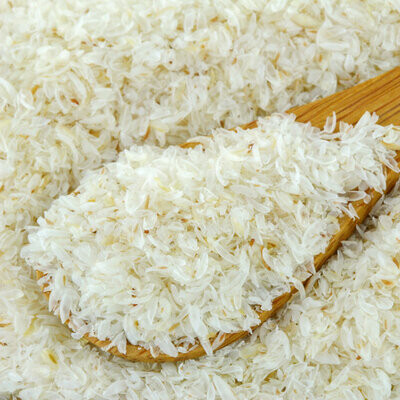Psyllium Husks
Also known as ispaghula or isabgol
What are Psyllium Husks?
Psyllium husks constitute the fibrous part of the Plantago ovata plant seed. It is a dietary fiber and a component of gluten-free baking. The unique colloidal properties of Psyllium provide for its functional and health benefits. 1
Psyllium husks can be commercially found as:
- Whole husks
- Husk powder
Origin
Psyllium (Plantago ovata) is an ancient plant which originated in the Mediterranean region of Southern Europe and North Africa. It has been used for medicinal purposes in Arabian and Persian societies. In India, psyllium is one of the major cash crops of the country.1
Today, psyllium is promoted for its high fiber content. This makes it a promising alternative for wheat flour substitution and capacity to simulate the gluten network in gluten free breads.1
Function
Psyllium has several functions in baked systems:
- Provides structure by producing a colloidal system, psyllium can simulate gluten structure
- Good source of dietary fiber, both insoluble (30%) and soluble (70%).
- Imparts a mild nutty flavor
- Binding agent that aids in forming a homogeneous dough
- Thickenner that increases the viscosity of dough and batter systems
- Retards staling
- Improves texture
Nutrition
Typical nutritional value of commercially available psyllium husks per 100 g:3
Psyllium husks provide 350 kcal per 100g. Commonly used as laxative due to its high soluble fiber content and for relief from constipation. It may also aid in reducing the glycemic index, lowering cholesterol and subsequently reducing the risk of heart disease. 3
Commercial production
Psyllium husks is commercially extracted through the following process:2
- Raw material procuring.
- Cleaning: psyllium seeds are passed through coarse screens to remove stones, straws and other impurities.
- Metal impurities removal: using magnets.
- Husk removal: using spinning rubber rollers.
- Wynonwing: husks are passed through gravity separators for further purification.
- Packagin
Application
Psyllium husks and psyllium husks powder can be used in the production of gluten free products like cookies, bread, cakes, pizza among others. It can substitute for guar gum, xanthan gum or flaxseed meal in baked goods. Replacement is typically 2:1 for guar or xanthan gums.4,5
Considerations when using psyllium husks in bakery products:1
| Baked goods | Usage level5 | Column 3 |
|---|---|---|
| Bread | 2 teaspoon per cup of flour |
|
| Cakes | 1 teaspoon per cup of flour or 7.5% |
|
| Cookies | ½ teaspoon per cup of flour |
|
| Muffin | 1 ½ teaspoon per cup of flour |
|
Regulations
Psyllium husks are considered safe by the FDA. 21CFR Part 101.81 establishes the characteristics of psyllium husk that can be used for allowed health claims. 6
In the EU, P. ovata is not considered a novel food product, and thus is not subject to the Novel Food Regulation. However, there may be other legislation restricting its use in some member states.7
References
- Alier, M, and Casaño,M.J. Gluten-Free Bread. Babelcube Inc., 2016.
- Arendt, E and Dal Bello, F. Gluten-free cereal products and beverages. Elsevier, 2011.
- U.S. Department of Agriculture, Agricultural Research Service. FoodData Central, 18 June 2018.https://fdc.nal.usda.gov/fdc-app.html#/food-details/1666127/nutrients . Accessed 13 September 2021.
- Beikzadeh, S, et al. “Effect of psyllium husk on physical, nutritional, sensory and staling properties of dietary prebiotic sponge cake.” Czech Journal of Food Sciences 34.6 (2016): 534-540.
- Gluten Free Palate. “Gluten-Free Binding Agents.” Glutenfreepalate.Com, 2021, https://www.glutenfreepalate.com/binding-agents/ , Accessed 19 September 2021.
- Food and Drug Administration (FDA). US Department of Health and Human Services. CFR Code of Federal Regulations Title 21, Part 101 Food Labeling, https://www.accessdata.fda.gov/scripts/cdrh/cfdocs/cfCFR/CFRSearch.cfm?fr=101.81&SearchTerm=soluble%20fiber , Accessed 19 September 2021.
- EU Commission. “EU Novel Food Catalogue (V.1.2).” Ec.Europa.Eu, 2021, https://ec.europa.eu/food/safety/novel_food/catalogue/search/public/?event=home&seqfce=272# , Accessed 19 September 2021.


